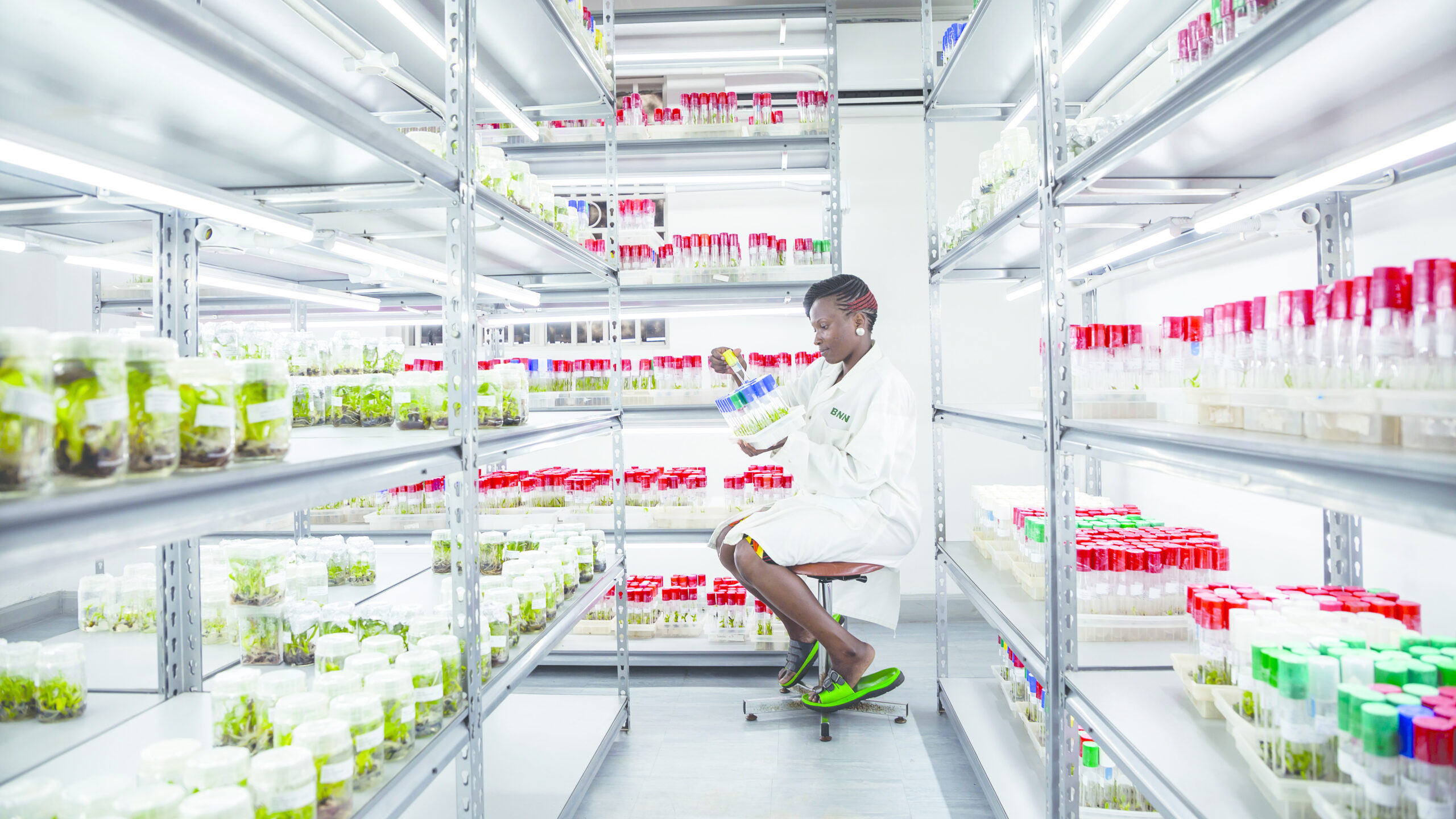In the early months of the COVID-19 pandemic, lockdowns and other measures restricting the movements of people and goods led to disruptions in food value chains, particularly in low- and middle-income countries (LMICs)—quickly followed by a number of surprisingly rapid adaptations and innovations to keep food supplies flowing. What is the situation now, two years after the start of the pandemic?
Food value chains in LMICs have expanded and lengthened immensely in recent decades to serve rapidly growing cities while meeting rural demand. This made them more vulnerable to shocks— but rapid development in logistics, processing, and wholesale practices created more capacity to respond. As the pandemic has continued, innovations in e-commerce, worker benefits, and automation have helped to fill supply chain gaps.
Through 2020 and 2021, the initial disruptions faded or became more scattered. Meanwhile, many consumers continued new behaviors adopted during the lockdowns—such as relying more on food e-commerce and delivery, including in China and India (Reardon, Heiman et al. 2021). Second, demand surged as consumer incomes recovered from 2020. Third, disruptions of cargo shipping, container inventories, and ports, initially perceived as a short-term problem, continued.
In 2021, additional weather-related shocks also struck food supply chains, including La Niña, which led to droughts in South America and stronger-than-normal tropical cyclones striking Central America and Southeast Asia.
Yet supply chains proved suprisingly resilient. During the main lockdowns of 2020, sales of many LMIC supply chains showed a V shape, first plummeting for three to four months, and then bouncing back to normal or near normal (Belton et al. 2021; Liverpool-Tasie et al. 2022). While some smaller firms did not recover, a growing body of evidence shows that the great majority survived (Dejene et al. forthcoming1).
Here, we want to focus on the right-hand side of the V: The upturn and resumption of business sales, and why and how it occurred. Building on our previous blog posts and studies, we focus on three key “pivots” that firms successfully made in sales, production, and procurement to adjust to the supply and demand shocks (Reardon, Heiman et al. 2021; Reardon and Swinnen 2020; Reardon and Vos 2021).
Sales pivot to e-commerce and delivery
COVID-19 greatly accelerated the global expansion of e-commerce, and served as a key resilience strategy for retailers and food service firms in 2020 and 2021, especially in Asia and Latin America. In Africa, because of high transaction costs, the expansion before and even during the pandemic was more limited, as illustrated by the difficulties Africa’s Jumia has found in trying to build its e-commerce business (Reardon, Belton et al. 2021.).
In particular, e-commerce in LMICs has innovated and differentiated to enable participation by retailers of different sizes and by different strata of consumers:
- Digitally based delivery options expanded into hyper-local and hyper-rapid service. For example, Getir (started in Turkey in 2021) expanded into Western Europe and North Africa.
- E-commerce “broadened” to serve small and medium enterprises (SMEs), including wet-market stall owners; for example, Getir started Getirçarşı, a division delivering only for SME retailers. In India, Swiggy delivers for food service SMEs and Jiomart (a division of Reliance) provides e-commerce platforms for small retail shops.
- E-commerce “stretched” into social media. For example, multichannel network companies like TikTok and Kuaishou in China helped e-commerce firms promote their food products, and wholesale markets such as Xinfadi in Beijing provided venues and equipment to support this.
Yet the shift to digitalization and business in cyberspace also means vulnerability to cyber-attacks. This became dramatically clear in 2021 when the network of JBS, the world’s largest meat firm, was hacked, operations disrupted, and a ransom paid. Such attacks are a major threat to the global food system, including in LMICs, as the digitalization of food markets as well as of internal operations of firms and farms increases exponentially.
Production pivots toward technologies that save labor and increase flexibility
In 2020 and 2021, many LMIC food industry firms faced a shortage of available (healthy) workers. This challenge was exacerbated by the need for many workers to take on new tasks, such as driving delivery vehicles and staffing fast-turnover warehouses that serve e-commerce.
To attract workers, firms had to invest in reconfigured workspaces for social distancing and in health protection gear. In 2021, food firms still faced severe labor shortages as—particularly in high income countries—many workers did not return to work. This labor shortage will likely remain a major challenge in 2022.
Firms have been responding in two ways:
- They have tried to encourage labor participation with better pay and working conditions and, for migrant workers, while governments have loosened visa requirements. For example, citrus packing plants in South Africa have provided incentives and training for local workers to replace migrant workers (Meyer, et al. 2021).
- Firms have automated parts of their operations and supply chains. China, for example, opened the world’s first fully automated port in Shandong in October 2021. Brazil’s pork processor Frimesa invested in automation of its plants in 2020, as did Marel with poultry processing in 2021.
This will bring societal challenges. Over time, firms and farms that automate will likely employ fewer nonskilled workers—despite the pressing need for jobs for the burgeoning “youth bulge” in the poorer LMICs.
Procurement pivots from “just in time” to “just in case”
Meanwhile, as food industry firms in LMICs (and developed countries) have been slammed by supply chain logjams in both international and domestic markets, buyers and sellers pivoted to diversify and pursue greater flexibility. The procurement of citrus products in South Africa illustrates this trend (Meyer et al. 2021).
In 2020, citrus retailers and wholesalers in Asia switched to sourcing more from South Africa when lockdowns caused supply constraints among traditional providers. South Africa’s government and its citrus industry were prepared, having already obtained market entry and certifications to sell to Asia in 2018 and 2019. When Europe locked down ports in 2020, South African citrus traders were able to redirect exports to Asia. Moreover, South African citrus supply chains were “trained” in flexibility, as they had been forced to adapt rapidly to waves of new European phytosanitary regulations over the decade preceding COVID-19.
Many food industry firms have found that redundancy of suppliers and assets is crucial for pivoting as well as for absorbing shocks. When one factory or port was locked down or short on labor or materials, others in that firm’s supply chain could pick up the work. Enterprises are shifting away from a focus solely on tight supply chains for efficiency, such as maintaining minimal inventories (called “just-in-time”), toward a “just-in-case” strategy, which emphasizes maintaining a degree of redundancy, flexibility, and diversification rather than strict efficiency (Masters and Edgecliffe-Johnson). Examples include:
- The Thai multinational Charoen Pokphand built a series of ports on the river they use for exports, so that if one is washed out by a typhoon, another can be activated (Reardon and Zilberman 2018).
- When consumers in South Africa rushed to stock up on maize meal, they put a sudden, tremendous strain on maize mills. The industry had lamented under-utilization of capacity before 2020, but was able to easily meet the demand surge by moving to full utilization, turning the slack into an asset during the pandemic (Meyer et al. 2021).
These strategies also pose a societal challenge, as they are likely to accelerate food industry concentration in both LMICs and developed countries. Large enterprises have an advantage, given their greater financial capacity and broader geographic spread of procurement and marketing. SMEs are dependent on smaller supply and marketing geographies and usually cannot afford to make investments in extra facilities or leave capacity unused.
Policy lessons: Invest in the food system’s “blood and bones” to strengthen firm resilience
These innovations would not have occurred without public investments in the infrastructure and markets that form the structure of food systems, and public policies that facilitate efficient exchange and private sector innovations, the flow of food systems. Given these evolving trends and the risk of future shocks, governments should embrace actions to enable private sector entrepreneurs, large and small, to pivot as a resilience strategy through innovations in marketing, sourcing, and technology. To facilitate such pivots, governments need to strengthen the support system—the “blood” and “bones”—on which food value chains depend.
- Investing in roads, wholesale markets, and other infrastructure (the “bones”) is crucial to reducing transaction costs, and thus firms’ flexibility and ability to pivot in sourcing and marketing. Where the bones are strong, such as the South African port system, firms can pivot quickly. Where the bones are weaker and transaction costs are high, firms are held back, as noted in the Africa case of Jumia above.
- Facilitating logistics, wholesale sectors, and efficient exchange and innovations (the “blood”) is key to the resilience of the whole system. Governments must get the enabling business environment right—implementing regulations designed to ease doing business, limiting concentration, setting transparent safety standards, reducing cybersecurity risks, and supporting access to finance, especially for SMEs.
These recommendations are critical to ensure resilience, innovation, and flexibility in our food supply chains as new waves of COVID-19 or new shocks arise.
Thomas Reardon is a University Distinguished Professor at Michigan State University and Non-Resident IFPRI Senior Research Fellow; Johan Swinnen is Director General of IFPRI; Rob Vos is Director of IFPRI’s Markets, Trade, and Institutions Division.
1. Dejene, S., R. Kabir, N. Minot, L. Nabwire, S. Harayanan, B. Rice, B. Van Campenhout, and R.Vos. Forthcoming. Impact of COVID-19 on food value chains in Bangladesh, Burkina Faso, and Uganda. Results of surveys of farmers, traders, and processors. IFPRI Working Paper. IFPRI, Washington, DC.







